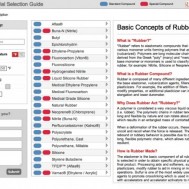Thanks for checking back for our final post in the 25 Materials of Christmas series! Take a look at some material basics and learn about the last of the materials available at Apple Rubber. Visit our previous posts for Materials #1-19!
Styrene Butadiene was the elastomer substituted for Natural Rubber during World War II. The main use for this material today is in the manufacture of automobile tires, because it exhibits excellent resistance to brake fluids. It is also still used in some brake applications.
The temperature range of Styrene Butadiene is -50° to +212°F (Dry Heat Only), with a Hardness (Shore A) of 40 to 90.
TFE/P™ (Aflas®) is a copolymer of tetrafluoroethylene/propylene, and can offer a combination of high temperature and chemical resistance. The main uses for this material are in seals for oil field, aerospace, chemical and general industrial environments.
TFE/P features a resistance to acids and bases, steam/hot water, corrosion inhibitors, oils and lubricants, and industrial solvents. The material has a temperature range of -14° to +446°F, with a Hardness (Shore A) of 60 to 90.
Vamac® [Ethylene/Acrylic] exhibits properties similar to those of polyacrylate, but with an extended low temperature limit and better mechanicals.
The key uses for Vamac® are in seals for automotive applications, such as automatic transmissions and power steering systems.
The temperature range of the standard compound is -13° to +338°F (Dry Heat Only), and of the special compound is -40° to +338°F, with a Hardness (Shore A) of 50 to 90.
Material basics:
Rubber refers to the elastomeric compounds that consist of various monomer units forming polymers that are heat cured (vulcanized). Polymers are long molecular chains and are derived from the Greek “poly” (many) and “meros” (parts). The base monomer or monomers is used to classify the type of rubber. For example: Nitrile, Silicone or Neoprene.
Rubber Compounds: Rubber is composed of many different ingredients that include the base elastomer, vulcanization agents, fillers and plasticizers. For example, the addition of fillers can reinforce or modify properties, or additional plasticizer can increase elongation and lower durometer.
Thermoset vs. Thermoplastic: Thermoset polymers become permanently “set” in the presence of heat and do not soften in the presence of subsequent heating, whereas a thermoplastic material will soften when heated (and eventually liquefy) and harden when cooled.
Thermoset polymers possess superior mechanical, thermal, and chemical properties as well as better dimensional stability than thermoplastics. This is why thermoset (rubber) parts are generally preferred for sealing applications.
We hope you’ve enjoyed our 25 Materials of Christmas series! To learn more about any of the many materials available at Apple Rubber, or to request a free sample or quote for your sealing applications, visit our website.
